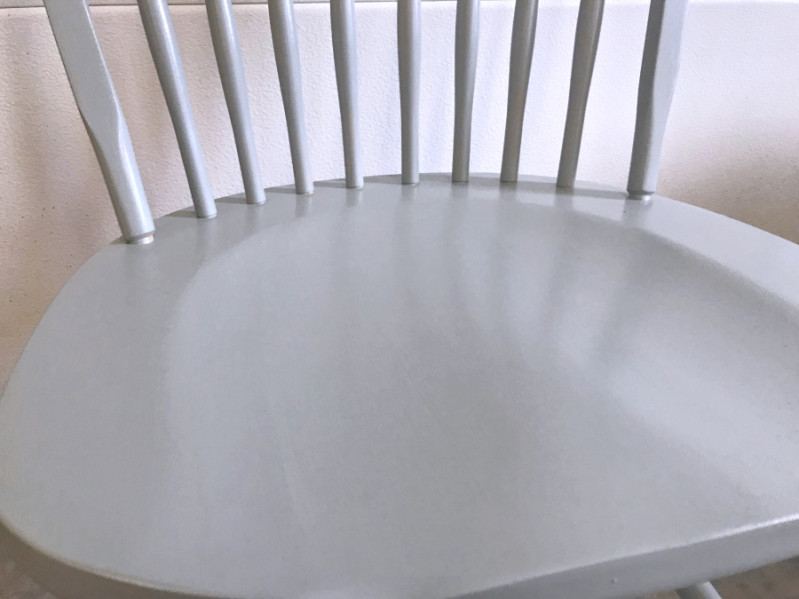Dear Vicki,
Could you tell me what your approach is when painting spindled chairs? Where do you start (spindles, seat, legs?) Do you paint the underside of the chair seat as well?
Thank you, Pamela
…
Yes. Thank you for asking. I can certainly go into more detail about how to paint wooden chairs.
.
When I received this note, I realized I have talked a lot about the best paint to use on chairs and benches in THIS post and THIS one. And using the right paint is important; because you can do a beautiful job applying paint to furniture, but if you use the wrong paint, you could end up with chipped paint and even strips of paint peeling off the furniture in the future.
.
Here is the exact process and products I use when painting chairs…

.
Step 1: Sand the Chairs
The first thing I do is sand the chairs with an electric rotary sander. THIS Dewalt sander is my favorite.
THESE are the 60-grit sanding discs I use. Do not substitute with the cheaper generic version. I’ve done this in the past, and the velcro backing rarely grips to the sander, rendering them useless.
The rotary sander will only be able to hit the flat surfaces of the chair and the thicker legs. You will need to hand-sand the spindles. The goal is to remove the majority of the gloss from any old clearcoat finish that was on the chairs.
Always sand furniture outside and wear a P-100 vapor mask and protective goggles.

.
Step 2: Prep the Chairs
While the chairs are still outside, use a leaf blower like THIS one to blow off the majority of the sanding dust.
Then wipe the chairs down with a cotton rag. Do this once or twice or until the rag is clean after you wipe.
.
Step 5: Choose the Right Brush
I’ve used several types of brushes and rollers over the years. Some people suggest using a round brush on chair spindles – I am not one of those people. A round brush would put too much paint on the brush among other things.
I use THIS 1-1/2 inch Super Trim Purdy Clearcut brush. The clearcut is much thinner than other brushes so it’s easier to add just the right amount of (but not too much) ) paint to the brush.
It’s better to add several thin coats of paint than one thick coat. You’ll have fewer brush marks and a smoother finished coat of paint.
.
Step 4: Prime the Chairs (sometimes)
If you choose a dark color paint and if you use enamel paint I suggest in my Painting Furniture ebook, then you will not need to prime the chairs because the enamel paint adheres and hardens so well.
If you choose a light to medium color, paint on 1 to 2 coats of primer.
Use THIS BIN shellac primer under all white paints. It’s the best stain-blocking primer I’ve used.

.
Step 5: Choose the Right Paint
You can learn more about the exact brand of enamel paint I use on chairs along with tips on how to manipulate the paint for a smoother (no brush strokes) finish in my Painting Furniture ebook: (click image for more info)
.
Step 5: Parts of the Chairs to Prime & Paint
In short, the answer to Pamela’s original question about which parts of the chair to paint is…. everywhere. Here are some tips on how I do this exactly and in which order…
- Tip the chair over to expose the underneath. Paint the underneath part of the seat first, only to the flat edge. Do not attempt to pain the side of the seat yet so you don’t end up with a thick paint line.
It’s very important that you paint in thin coats. Do not add too much paint to the brush, otherwise you’ll end up with a thick line of paint right at the portions you cannot see, but will be visible when you tip the chair back over.
- Then paint as much of the chair legs and the cross spindle between the legs as you can see.
- Move on to the chairback. While the chair is still tipped over, paint the underneath of the chairback, where the spindle meets the top of the chairback.
- Very lightly paint the spindles. Remember… thin coats of paint so you don’t end up with a paint line when you flip the chair over.
- Now you can flip the chair over and stand it upright.
- Paint any portion of the chair legs and cross spindle between he legs that needs more paint. Then do the same to the spindles on the chairback.
- Next paint the top rail of the chair back.
Where the spindles and top rail of the chairback meet the chair seat, be sure no paint puddles here. Smooth out any that does.
- Paint the chair seat last, working left to right with single, long brush strokes that go from the back of the seat to the front.
- Finally, repeat the process with a second coat of paint. And a third if needed.
.

Hope you found this helpful

Disclosure: This post contains affiliate links to products I use myself.
.
.
.
.
.
.
..








Leave a Reply